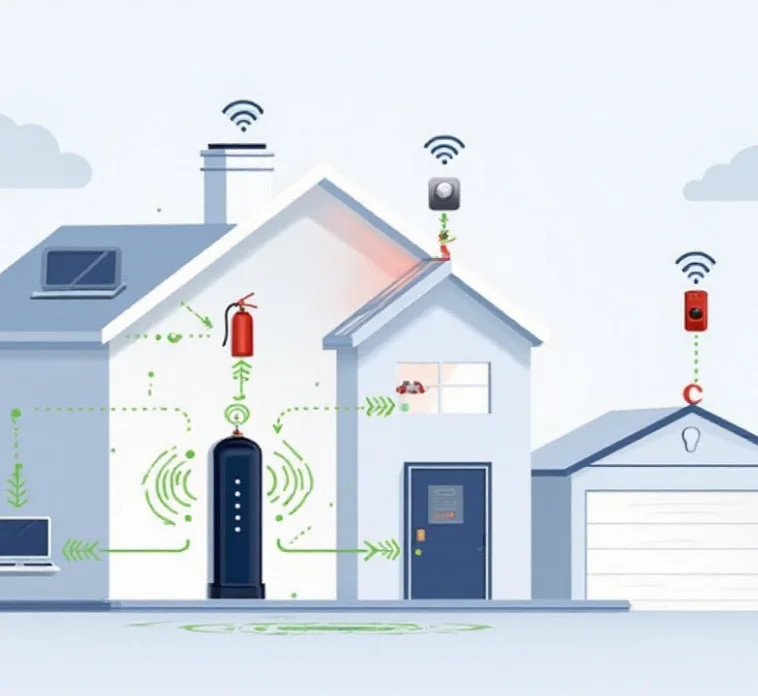We all need Wi-Fi for work, streaming, smart home devices, and other things. One ubiquitous question, though, is whether Wi-Fi can pass through walls. The brief response is yes; Wi-Fi signals pass through walls, but their performance varies. The kind of wall and other barriers in your house might completely block or weaken the signal.
This guide will walk through Wi-Fi’s operation, how walls affect it, and how you might enhance your signal. We will also discuss the best Wi-Fi extenders for use with brick and concrete walls and address frequently asked questions, including “Can Wi-Fi go through floors?” and “Do mirrors block Wi-Fi?”
Wi-Fi: An Easy Justification for How It Works
Wi-Fi—Wireless Fidelity—allows your router to broadcast data to your devices using radio waves. These waves float over the air just as your chosen FM or AM station does. Mostly in the 2.4GHz, 5GHz, and now 6GHz ranges, Wi-Fi runs at higher frequencies. Wi-Fi can travel through walls; however, it is not always efficient in that case.
For quick data transfers, these frequencies are ideal, but solid materials like walls, metal, or concrete can block or weaken them.
Does Wi-Fi Pass Through Walls?
Some materials cut the signal less than others.
Different walls impact Wi-Fi as follows:
- Wi-Fi flows across drywall or plaster walls, albeit with a small signal drop.
- Harder Wi-Fi access is behind brick walls. The signal loses a lot.
- Wi-Fi finds trouble here in the concrete walls. Your house could have dead zones.
- Wi-Fi can pass through glass walls; some varieties, such as mirrored or tinted glass, can reflect or absorb signals.
So, wifi is capable of passing through walls; however, it depends on the material of the walls.
Does Wi-Fi Traverse Ceilings and Floors?
Not too much will be blocked by wood or drywall flooring. Flooring made of concrete or metal can weaken your signal between levels.
Does a Refrigerator, Mirror, or Door Block Wi-Fi?
Particularly if they are metal or thick, doors can somewhat weaken signal strength.
Mirrors produce interference and can reflect Wi-Fi signals.
Other major appliances, including refrigerators, can block or bounce off Wi-Fi signals.
Try rotating your router for better coverage if it is close to a mirror or refrigerator.
Which Wi-Fi Frequency More Effectively Passes Through Walls?
Traveling farther and penetrating walls more effectively than the 5GHz or 6GHz bands, the 2.4GHz band. Although Wi-Fi 7 is the fastest and provides the lowest latency, especially in open areas, the more recent Wi-Fi 6 and Wi-Fi 6E standards offer enhanced performance.
Using the 2.4GHz band will help you reach far-off rooms, whether your house is big or one with thick walls. If you live close to the router, however, 5 GHz or 6 GHz can provide faster speeds.
Is Complete Blocking of Wi-Fi Possible?
Sure. Complete Wi-Fi signal blocking can come from concrete walls, metal reinforcements, and electromagnetic interference. For this reason, some rooms have either a very poor or nonexistent internet connection. If you find some rooms with a poor signal, the walls are most certainly the cause.
How Can One Increase Wi-Fi Signal Across Walls?
Your Wi-Fi coverage will get better even with strong walls. Test these ideas:
- Position the router centrally; steer clear of placing it close to thick walls or corners.
- Use a mesh Wi-Fi system; in big homes, these outperform a single router.
- Get a Wi-Fi extender; especially helpful in larger areas or for thick walls.
- Powerline adapters send internet via the electrical wiring in your house.
- Move to routers based on Wi-Fi 6 or Wi-Fi 7. The signal and speed of more recent routers are better.
Top Wi-Fi Extenders for Concrete and Brick Walls
If your walls present a challenge, consider one of these highly rated choices:
- Great for big homes and concrete walls, Netgear Nighthawk Wi-Fi 6 Mesh Extender (EAX80)
- Powerful and reasonably priced TP-Link RE705X AX3000 Wi-Fi 6 Extender
- Great for brick walls and consistent signal strength, the SUS RP-AX58 AX3000 Dual Band Extender
These extenders help to eradicate dead zones and increase Wi-Fi across walls.
Review comments on Reddit: Are better wifi routers better at passing through walls?
Can One See Through Walls Using Wi-Fi?
This is an interesting one. Sometimes sophisticated sensors in Wi-Fi signals can detect motion across walls. Still, this is not something routers or other devices are designed to accomplish. It is mostly experimental or used for research.
Does Wi-Fi Cause You Any Damage?
Wi-Fi signals are not ionizing radiation, though. So, they are quite the opposite of X-rays and UV rays in that they don’t cause any damage to DNA or cells. You are safe using Wi-Fi in your house.
Typical Questions and FAQs
Through plaster walls, is Wi-Fi possible?
Through walls, can 5 GHz Wi-Fi pass?
Are mirrors able to block Wi-Fi?
Is Wi-Fi blocked by trees?
Do Wi-Fi extenders pass through walls?
Can floors allow Wi-Fi signals to pass through?
Building Materials’ Impact on Wi-Fi Signal Strength
Inquiring “Does Wi-Fi signal go through walls?” requires an awareness of how various building materials impact signal strength. Walls vary from one another. Different blocks signal depends on their frequency.
Common Wall Materials and Their Effects
- Wood and plywood – little signal loss. Wi-Fi passes right through wooden walls.
- Older homes sometimes make use of lath and plaster. Specifically, in modern energy-efficient windows, glass with a metal coating can reflect signals.
- Among the worst blockers are concrete, including steel rebar. Wi-Fi finds it difficult to pass.
This is the reason you might find your Wi-Fi strong in one room but quite poor just one wall away. Knowing this will enable you, depending on the design of your house, to select the best Wi-Fi extender for brick or concrete walls.
Where Should You Place Your Router for the Best Signal?
To improve Wi-Fi and ensure it passes through walls more effectively, you must position your router carefully.
Advice for Perfect Router Position:
- Keep it central to your house for consistent coverage in the middle.
- Mount it on a shelf or wall to raise it. Wi-Fi moves better downward and outward.
- Avoid using metal things, and also make sure that they are not near metal cabinets, fridges, and microwaves.
- Keep it clear: Wi-Fi runs better free from the direct front of the router.
Your router is likely to perform poorly if it is in a corner behind thick concrete walls. If relocation isn’t possible, think about installing a Wi-Fi extender that passes through walls.
Selecting a Wi-Fi Extender for Walls
Not all Wi-Fi extenders are equal. Dealing with brick, concrete, or metal walls calls for tools meant for heavy-duty performance.
Look for what a good Wi-Fi extender offers:
- Dual-band or tri-band helps control more devices and enhances wall-through performance.
- Support for Wi-Fi either 6 or 7: These more recent benchmarks increase signal speed and range.
- High-gain antennas enable signals to reach farther and more effectively pass obstacles.
- Works perfectly for complete home coverage using other routers or extenders.
Investing in the best Wi-Fi for concrete walls will greatly enhance your home network if you are having dead areas.
For Walls, What Is Better—Mesh Wi-Fi or Wi-Fi Extenders?
Here’s what to think about if you’re choosing between conventional Wi-Fi extenders and mesh Wi-Fi systems:
Systems of Mesh:
- Work as a team of devices dispersed throughout your house.
- Over walls and floors, offering faster speeds and stronger signals.
- Perfect for big houses or those featuring several thick walls.
Extending Wi-Fi:
- Work with your current router.
- Less expensive and simpler to set up.
- Perfect for single trouble spots or small areas.
Usually, a mesh system is more dependable if your house has concrete or brick walls. However, a strong Wi-Fi extender for walls can be a more reasonably priced option if you only have one or two dead zones.
Can Wi-Fi Cross Several Walls?
Wi-Fi can pass through several walls, but each extra wall lowers the signal considerably more.
As one example:
- One dry wall could cut the signal by five to ten percent.
- One brick wall could cut between 25 and 50%.
- The signal can be virtually totally killed by two concrete walls.
Hence, even if Wi-Fi signals can pass through walls, too many obstacles will result in poor, erratic connections. This is why it’s so important to position your router in the best possible location and, where necessary, employ extenders.
Advanced Wi-Fi Advice for Homes Built from Thick Walls
These smart ideas can help you if your apartment or older house has concrete or metal walls:
- For faster unit communication, use Ethernet backhaul with mesh systems.
- Replace simply extenders with access points. Better speeds and Ethernet-connected access points for link devices.
- For smart TVs or gaming consoles, wherever possible, switch to wired connections.
- Check your router often for improvements. Older routers do not support contemporary Wi-Fi standards, which better handle the walls.
These actions can help you maximize Wi-Fi across walls and enhance your online experience even in the most demanding surroundings.
Do Wi-Fi Signals Bounce Off of Walls?
Indeed, Wi-Fi can bounce off walls, especially metal or reflective surfaces. “Signal reflection,” or interference resulting from this bouncing, could compromise connection quality. Sometimes bouncing signals help cover challenging corners. More usually, though, they simply result in erratic speeds.
Therefore, the location of the router is quite important since you want direct paths to devices, free from depending on signal bounce.
Finally, Does Wi-Fi Pass Across Walls?
Indeed, Wi-Fi can pass through walls, but the material will affect how effectively it does. Using mesh systems, extenders, or router upgrades will help you greatly increase Wi-Fi across walls if you find weak signals.
Knowing what influences your signal helps you to quickly solve Wi-Fi issues and enjoy a consistent connection all around your house.

















